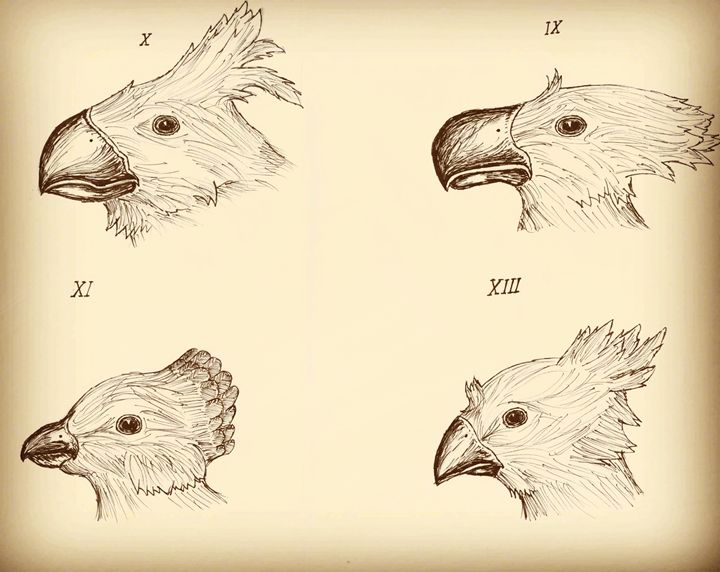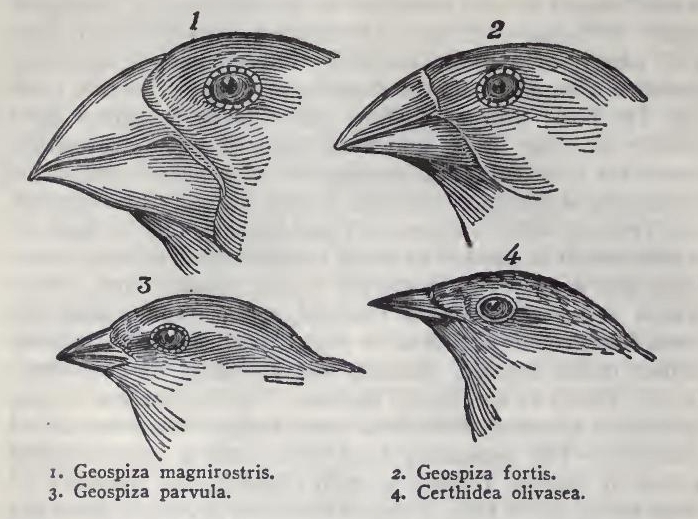
‘People have taken this extremely arid place and tried to turn it into a Caribbean resort.’Īcademy Bay records dating back to the early 1960s show that medium ground finches captured there had either small or large bills.
#Darwin bird sketch full#
Today Puerto Ayora is full of hotels and mai tai bars,’ Hendry says. The human population of the area has been growing fast-from 900 people in 1974 to 9,582 in 2001. Their study focused on birds living near the Academy Bay research station, on the fringe of the town of Puerto Ayora. On the inhabited island of Santa Cruz, just south of Daphne Major, Andrew Hendry of McGill University and Jeffrey Podos of the University of Massachusetts at Amherst have discovered a new, man-made twist in finch evolution. This situation, says Peter Grant, marked the first time that biologists have been able to follow the complete process of an evolutionary change due to competition between species and the strongest response to natural selection that he had seen in 33 years of tracking Galápagos finches. When wetter weather returned in 2004, and the finches nested again, the new generation of the medium ground finch was dominated by smaller birds with smaller bills, able to survive on smaller seeds. Medium ground finches with large bills, crowded out of feeding areas by the more powerful large ground finches, were hit particularly hard. None of the birds nested that year, and many died out. ‘We realized,’ Peter Grant says, ‘we had a very unusual and potentially important event to follow.’ For 20 years, the large ground finch coexisted with the medium ground finch, which shared the supply of large seeds with its bigger-billed relative. Their arrival was the first such colonization recorded on the Galápagos in nearly a century of scientific observation. The stout bills of these birds resemble the business end of a crescent wrench. In 1982, a third finch, the large ground finch, came to live on Daphne Major. Recently, the Grants witnessed another form of natural selection acting on the medium ground finch: competition from bigger, stronger cousins. When local conditions reverse themselves, so does the direction of adaptation. ‘It happens when the environment changes. ‘Natural selection is observable,’ Rosemary Grant says. Small seeds came to dominate the food supply, and big birds with big bills died out at a higher rate than smaller ones. Vines and other plants that in most years struggle for survival suddenly flourished, choking out the plants that provide large seeds to the finches. The Grants had documented natural selection at work-the same process that, over many millennia, directed the evolution of the Galápagos’ 14 unique finch species, all descended from a common ancestor that reached the islands a few million years ago.Įight years later, heavy rains brought by an El Nino transformed the normally meager vegetation on Daphne Major.
#Darwin bird sketch crack#
Smaller members of the medium ground finch population, lacking the bill strength to crack large seeds, died out.īill and body size are inherited traits, and the next generation had a high proportion of big-billed individuals. When a severe drought hit in 1977, the birds soon devoured the last of the small, easily eaten seeds.

The island is so small that the researchers were able to count and catalogue every bird. When the Grants began their study in the 1970s, only two species of finch lived on Daphne Major, the medium ground finch and the cactus finch. Its bill is a middling example in the array of shapes and sizes found among Galápagos finches: heftier than that of the small ground finch, which specializes in eating small, soft seeds, but petite compared to that of the large ground finch, an expert at cracking and devouring big, hard seeds.


At first glance, it may not seem particularly striking, but among scientists who study evolutionary biology, the medium ground finch is a superstar. The plumage of this sparrow-sized bird ranges from dull brown to jet black. The Grants’ most dramatic insights have come from watching the evolving bill of the medium ground finch. They have witnessed Darwin’s principle in action again and again, over many generations of finches. On Daphne Major-one of the most desolate of the Galápagos Islands, an uninhabited volcanic cone where cacti and shrubs seldom grow higher than a researcher’s knee-Peter and Rosemary Grant have spent more than three decades watching Darwin’s finch respond to the challenges of storms, drought and competition for food Biologists at Princeton University, the Grants know and recognize many of the individual birds on the island and can trace the birds’ lineages hack through time.


 0 kommentar(er)
0 kommentar(er)
